General Periodical Cicadas
Published by Reblogs - Credits in Posts,
General Periodical Cicada Information
Periodical cicadas (Magicicada spp.) are among the most unusual of insects, with long life cycles, infrequent, periodic mass emergences, striking appearance, and noisy behaviors. Periodical cicada emergences are notable not only because they involve large numbers of insects, but because those insects are striking in appearance, loud, and extremely active… but only for a brief period.
No Magicicada are expected to emerge in 2022. Brood XI would have emerged, but this brood has gone extinct. However, plenty of cicadas emerge off-cycle. These cicadas, known as "stragglers," can sometimes reach significant densities. Stragglers seem most common ±1 or ±4 years surrounding the emergence of their brood. However, other timings are possible; for example, stragglers are being reported in 2022; some of these cicadas seem to be emerging 1 year late in the territory of Brood X, but others are emerging 2 years early in the territory of Brood XIX.

Periodical cicadas are found only in eastern North America. There are seven species — four with 13-year life cycles and three with 17-year cycles. The three 17-year species are generally northern in distribution, while the 13-year species are generally southern and midwestern. The periodical cicadas can be divided into three species groups (-decim, -cassini, and -decula) with slight ecological differences. Magicicada are so synchronized developmentally that they are nearly absent as adults in the 12 or 16 years between emergences. When they do emerge after their long juvenile periods, they do so in huge numbers, forming much denser aggregations than those achieved by most other cicadas. Periodical cicada emergences in different regions are not synchronized, and different populations comprise the 15 largely parapatric periodical cicada "Broods," or year-classes.
Many people know periodical cicadas by the name "17-year locusts" or "13-year locusts", but they are not true locusts, which are a type of grasshopper. Their uniqueness has given them a special appeal and cultural status. Members of the Onondaga Nation near Syracuse NY maintain the oral tradition of being rescued from famine by periodical cicadas. Early European colonists viewed periodical cicadas with a mixture of religious apprehension and loathing. Modern Americans maintain numerous websites to assist in planning weddings, graduations, and other outdoor activities around Magicicada emergences.

Magicicada adults have black bodies and striking red eyes and orange wing veins, with a black "W" near the tips of the forewings. Most emerge in May and June. Some of the annual cicada species are sometimes mistaken for the periodical cicadas, especially those in the genera Diceroprocta and Okanagana; these other species emerge somewhat later in the year but may overlap with Magicicada. The Okanagana species are the most potentially confusing because some have similar black-and-orange coloration. Other Common North American non-periodical cicadas include the large, greenish "dog-day" cicadas (genus Neotibicen) found throughout the U.S. in the summer. Non-periodical cicadas are often called "annual cicadas" (even though they typically have multiple-year life cycles) because in a given location adults emerge every year. The best way to identify cicada species is by the sounds that they make, because cicada songs are nearly always species-specific.



Cicadas do not possess special defensive mechanisms — they do not sting or bite. The ovipositor is used only for laying eggs and the mouthparts are used only for feeding on twigs; thus, periodical cicadas can hurt you only if they mistake you for a tree branch! When approached, a cicada will simply fly away. If handled, both males and females struggle to fly, and males make a loud defensive buzzing sound that may startle but is otherwise harmless. Cicadas are not poisonous or known to transmit disease.
Cicada juveniles are called "nymphs" and live underground, sucking root fluids for food. Periodical cicadas spend five juvenile stages in their underground burrows, and during their 13 or 17 years underground they grow from approximately the size of a small ant to nearly the size of an adult.


Periodical cicada nymphs live underground for 13 or 17 years, keeping track of seasonal cycles (Karban et al. 2000) through some as-yet unknown mechanism. In the spring of their 13th or 17th year, a few weeks before emerging, the nymphs construct exit tunnels to the surface, with exit holes roughly 1/2 inch in diameter. Sometimes cicadas miscount and emerge unexpectedly early or late.

Sometimes, nymphs construct mud "turrets" surrounding their holes, though the context in which cicadas construct turrets and the functional significance of the turrets remains unknown.
Locally, periodical cicada emergences occur when soil temperatures at a depth of 7-8 inches reach approximately 64°F (Heath 1968). Because emergence is temperature-dependent, periodical cicadas tend to emerge earlier in southern and lower-elevation locations. For example, cicadas in South Carolina often begin to emerge in late April, while those in southern Michigan do not appear until June. The best way to predict the time of emergence for your area is to check records from the prior emergence in that location, by asking longtime residents or by searching local newspaper archives. Emerging nymphs leave their burrows after sunset (usually), locate a suitable spot on nearby vegetation, and complete their final molt to adulthood.

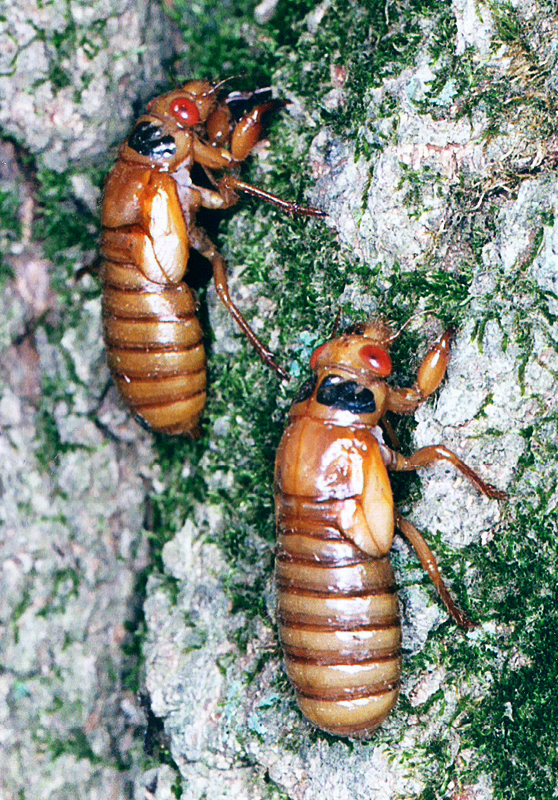
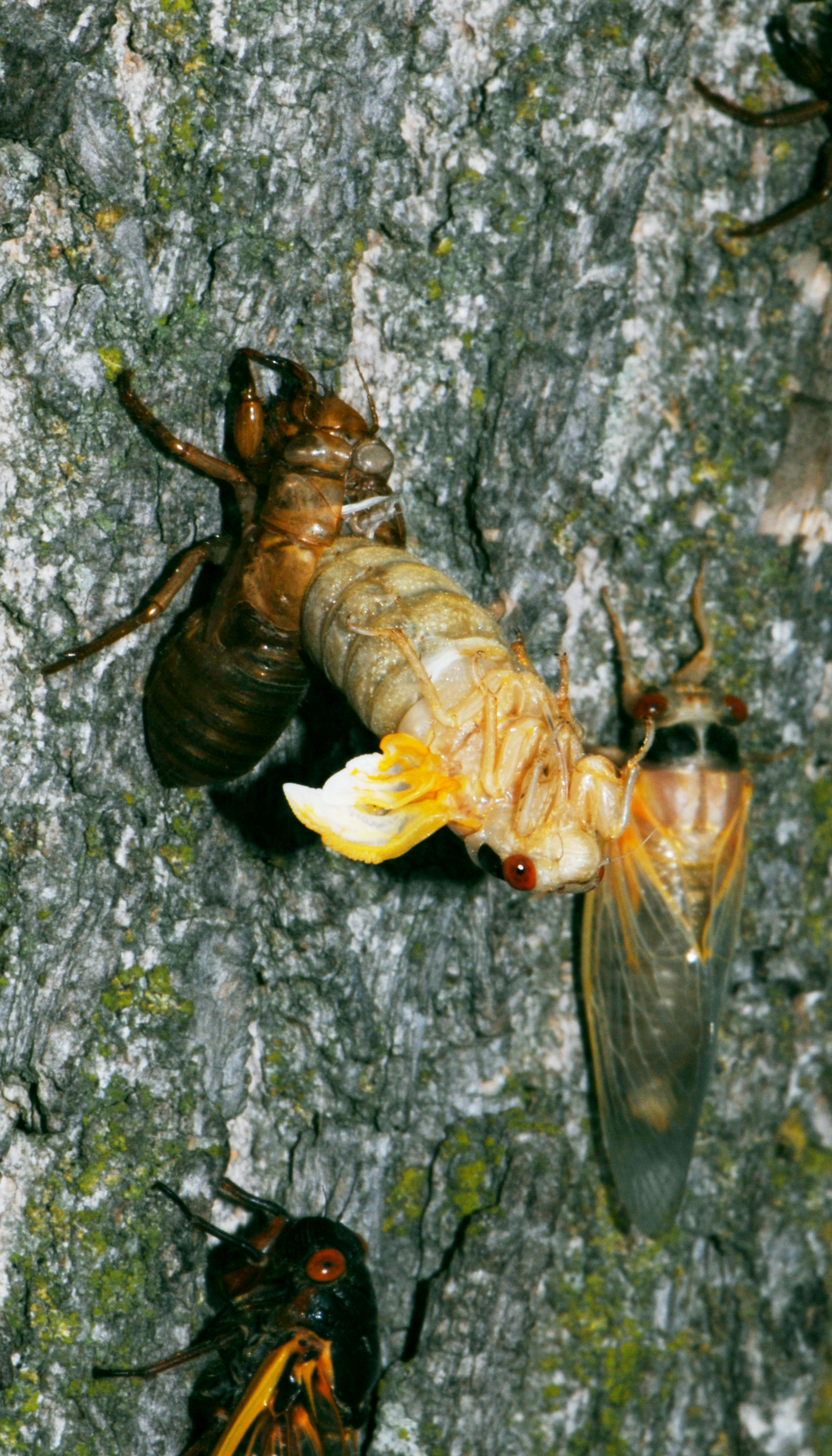
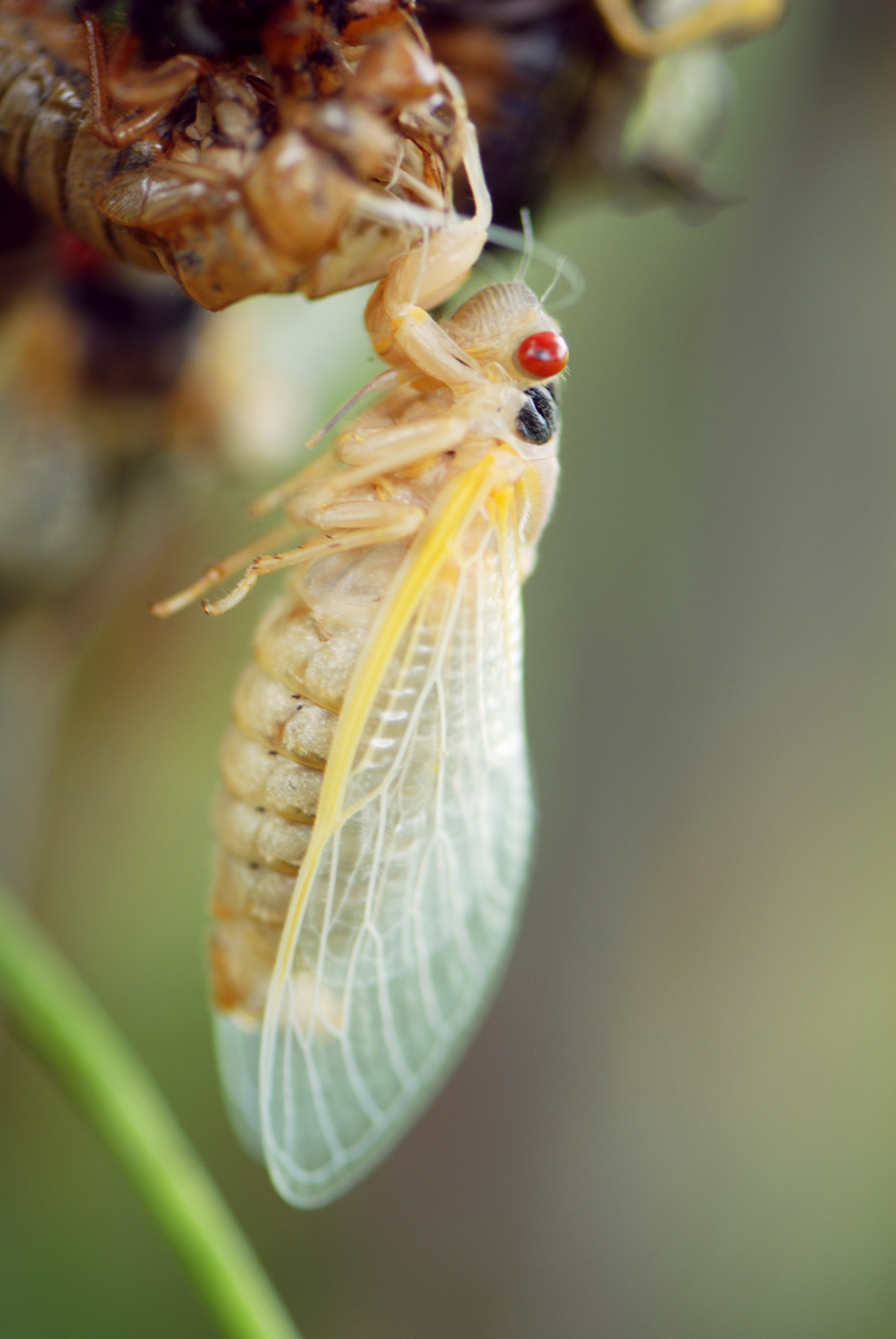
Shortly after ecdysis (molting) the new adults appear mostly white, but they darken quickly as the exoskeleton hardens. The cues that determine the particular night on which the nymphs emerge and molt are not well understood, but soil temperature probably plays an important role. Sometimes a large proportion of the population emerges in one night. Newly-emerged cicadas spend roughly four to six days as "teneral" adults before they harden completely (possibly longer in cool weather); they do not begin adult behavior until this period of maturation is complete.
After their short teneral period, males begin producing species-specific calling songs and form aggregations (choruses) that are sexually attractive to females. Males in these choruses alternate bouts of singing with short flights until they locate receptive females. Click here to learn more about their behavior.
Contrary to popular belief, adults do feed by sucking plant fluids; adult cicadas will die if not provided with living woody vegetation on which to feed. Adult Magicicada feed from a wide variety of deciduous plants and shrubs, but usually not from grasses.
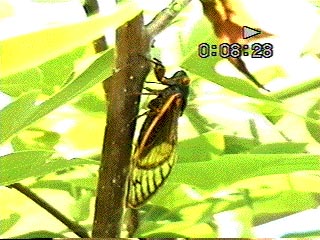
Mated females excavate a series of Y-shaped eggnests in living twigs and lay up to twenty eggs in each nest. A female may lay as many as 600 eggs.
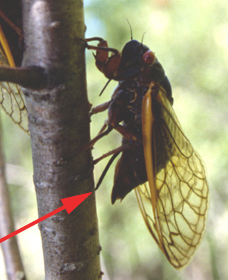
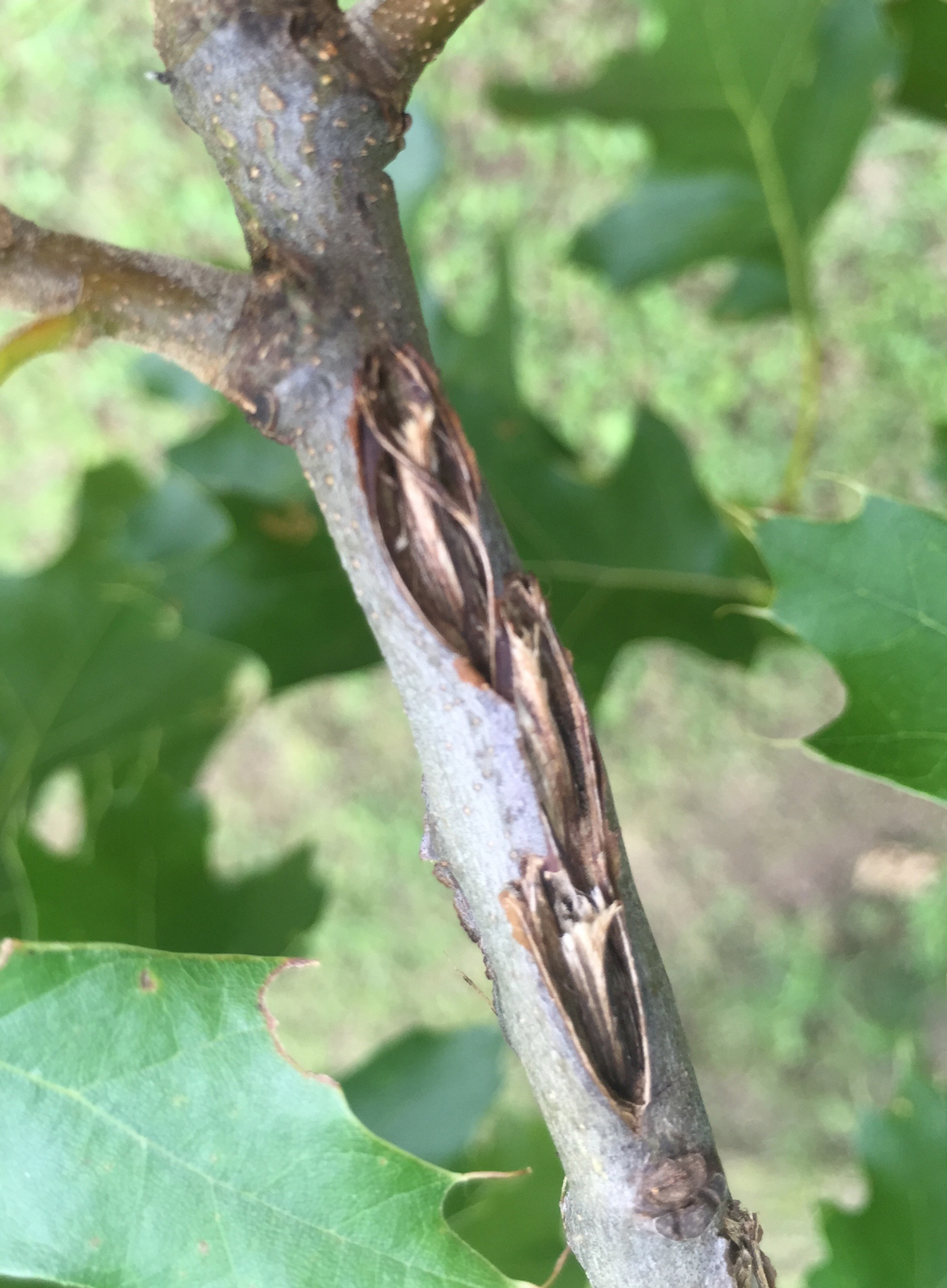
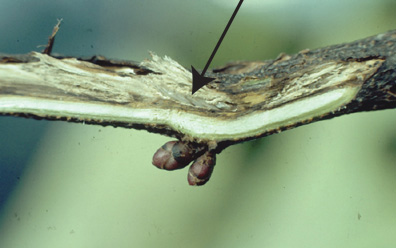
After six to ten weeks, the eggs hatch and the new first-instar nymphs drop from the trees, burrow underground, locate a suitable rootlet for feeding, and begin their long 13- or 17-year development.
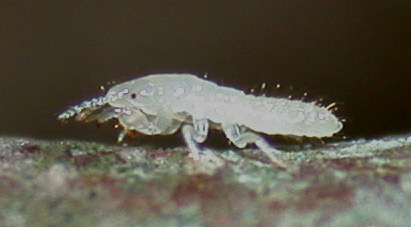
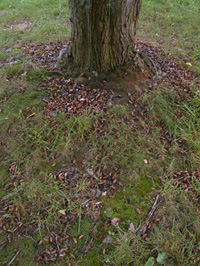
By the time that the nymphs hatch, the adults have died.
Periodical cicadas achieve astounding population densities, as high as 1.5 million per acre. Densities of tens to hundreds of thousands per acre are more common, but even this is far beyond the natural abundance of most other cicada species. Apparently because of their long life cycles and synchronous emergences, periodical cicadas escape natural population control by predators, even though everything from birds to spiders to snakes to dogs eats them opportunistically when they do appear. Magicicada population densities are so high that predators apparently eat their fill without significantly reducing the population (a phenomenon called "predator satiation"), and the predator populations cannot build up in response because the cicadas are available as food above ground only once every 13 or 17 years.

Magicicada do not have any specialized predators, though many different kinds of animals will eat them. Individual periodical cicadas are slower, less flighty, and easier to capture than other cicadas, probably because the safety afforded by their great numbers means that the risks of predation for an individual are low. Explaining the evolution of such an unusual life strategy is one of the most difficult problems for biologists.
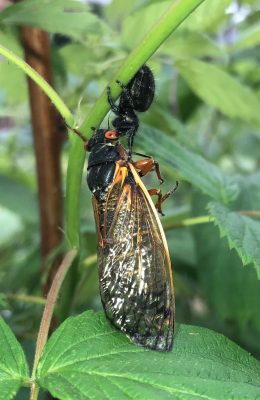
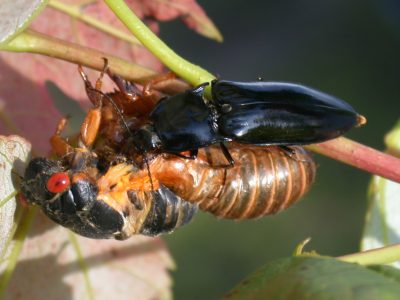
Literature
Alexander, R. D., and T. E. Moore. 1962. The evolutionary relationships of 17-year and 13-year cicadas, and three new species. (Homoptera: Cicadidae, Magicicada). University of Michigan Museum of Zoology Miscellaneous Publication 121:1-59.
Cooley, J. R., and D. C. Marshall. 2001. Sexual signaling in periodical cicadas, Magicicada spp. (Hemiptera: Cicadidae). Behaviour 138:827-855.
Cooley, J. R., C. Simon, D. C. Marshall, K. Slon, and C. Ehrhardt. 2001. Allochronic speciation, secondary contact, and reproductive character displacement in periodical cicadas (Hemiptera: Magicicada spp.): genetic, morphological, and behavioural evidence. Mol. Ecol. 10:661-671.
Cooley, J. R., D. C. Marshall, K. B. R. Hill, and C. Simon. 2006. Reconstructing asymmetrical reproductive character displacement in a periodical cicada contact zone. Journal Of Evolutionary Biology 19:855-868.
Cooley, J. R., G. Kritsky, J. D. Zyla, M. J. Edwards, C. Simon, D. C. Marshall, K. B. R. Hill, and R. Krauss. 2009. The Distribution of Periodical Cicada Brood X. The American Entomologist 55:106-112.
Cooley, J. R., D. C. Marshall, A. F. Richards, R. D. Alexander, M. D. Irwin, J. R. Coelho, and C. Simon. 2013. The distribution of periodical cicada Brood III in 1997, with special emphasis on Illinois (Hemiptera: Magicicada spp.). The American Entomologist 59:9-14.
Heath, J. E. 1968. Thermal Synchronization of Emergence in Periodical "17-year" Cicadas (Homoptera, Cicadidae, Magicicada). Am. Midl. Nat. 80:440-448.
Karban, R., C. A. Black, and S. A. Weinbaum. 2000. How 17-year cicadas keep track of time. Ecology Letters 3:253-256.
Kritsky, G. and R. A. Meyer. 1976. The emergence of the Periodical Cicada (Brood XXIII) in Illinois in 1976. Transactions of the Illinois State Academy of Science 69:196-197.
Lloyd, M., and H. S. Dybas. 1966a. The periodical cicada problem. I. Population ecology. Evolution 20:133-149.
Lloyd, M., and H. S. Dybas. 1966b. The periodical cicada problem. II. Evolution. Evolution 20:466-505.
Lloyd, M., G. Kritsky, and C. Simon. 1983. A Simple Mendelian Model for 13- and 17- Year Life Cycles of Periodical Cicadas, with Historical Evidence of Hybridization Between Them. Evolution 37:1162-1180.
Marlatt, C. L. 1923. The Periodical Cicada. United States Department of Agriculture, Bureau of Entomology Bulletin 71:1-183.
Martin, A., and C. Simon. 1988. Anomalous distribution of nuclear and mitochondrial DNA markers in periodical cicadas. Nature 336:237-239.
Martin, A., and C. Simon. 1990. Differing Levels of Among-Population Divergence in the Mitochondrial DNA of Periodical Cicadas Related to Historical Biogeography. Evolution 44:1066-1080.
Marshall, D. C., and J. R. Cooley. 2000. Reproductive Character Displacement and Speciation in Periodical Cicadas, with Description of a New Species, 13-Year Magicicada neotredecim. Evolution 54:1313-1325.
Simon, C. 1988. Evolution of 13- and 17-year periodical cicadas. Bulletin of the Entomological Society of America 34:163-176.
Simon, C., J. Tang, S. Dalwadi, G. Staley, J. Deniega, and T. R. Unnasch. 2000. Genetic Evidence for Assortative Mating between 13-Year Cicadas and Sympatric "17-Year Cicadas with 13-Year Life Cycles" Provides Support for Allochronic Speciation. Evolution 54:1326-1336.
Stannard, L. J. 1975. The distribution of periodical cicadas in Illinois. ll. Nat. Hist. Surv. Biol. Notes 91:3-12.
